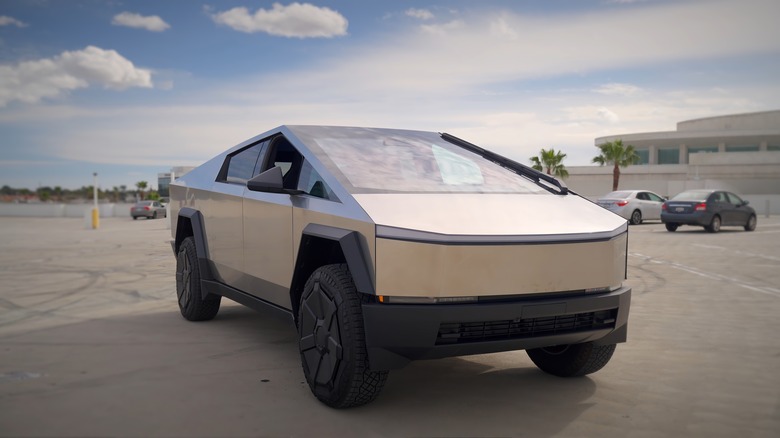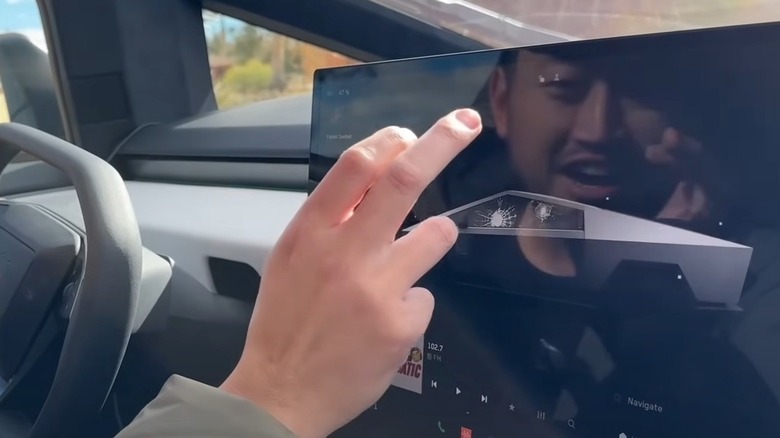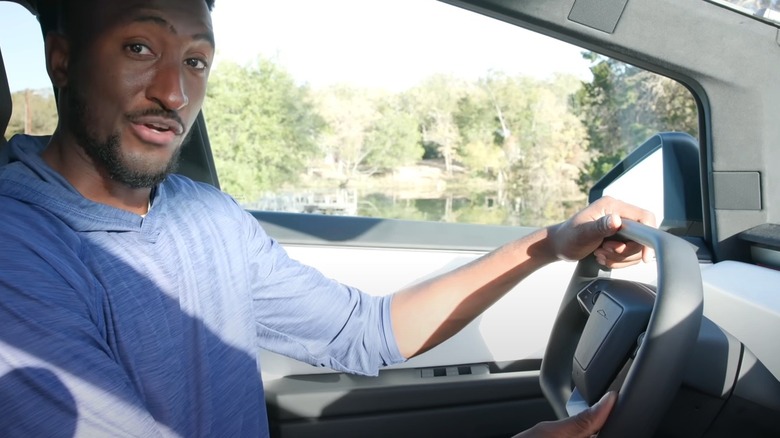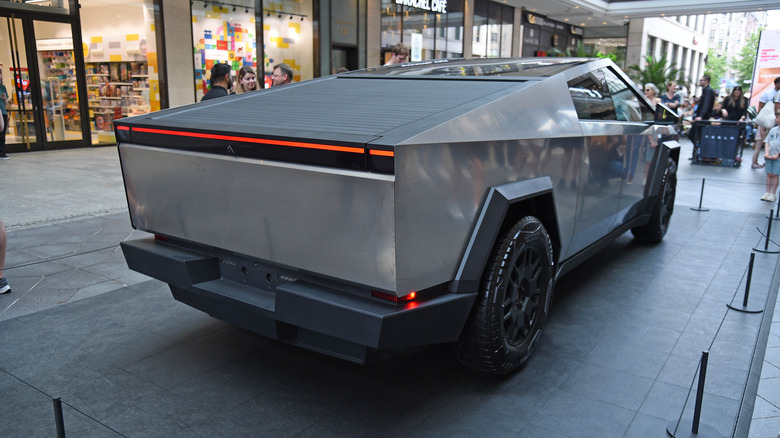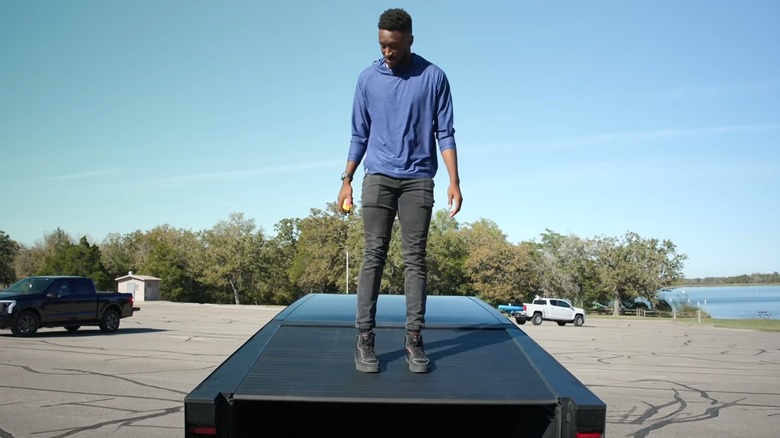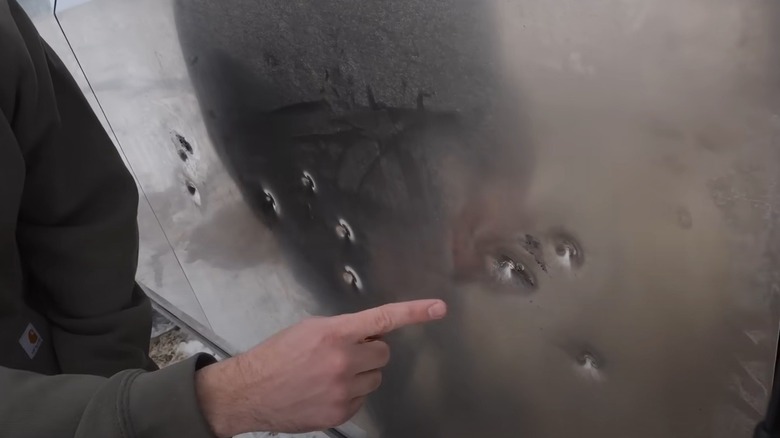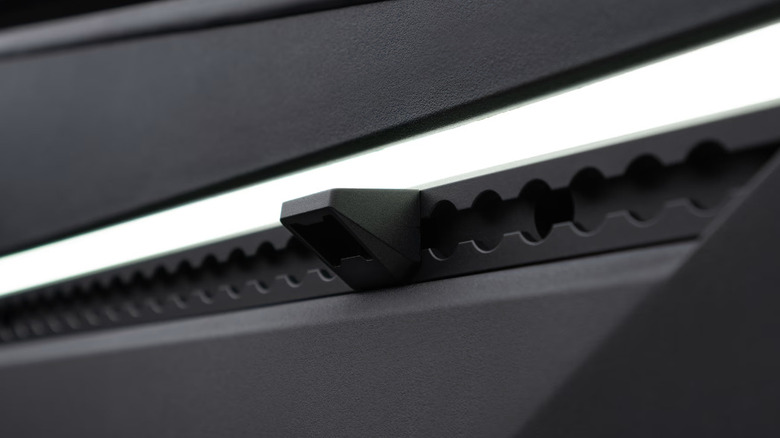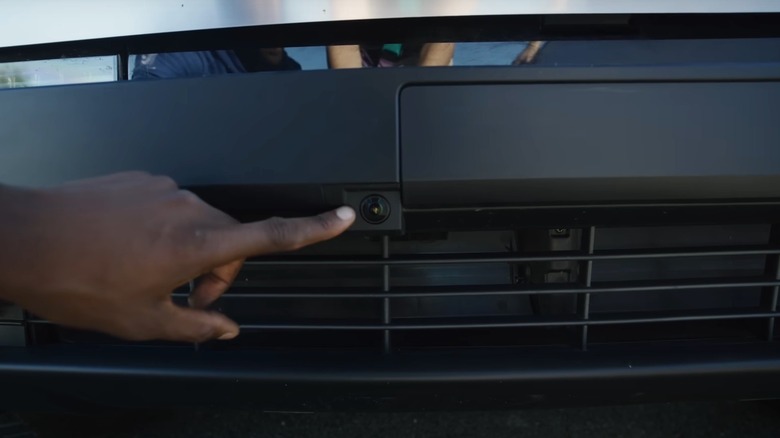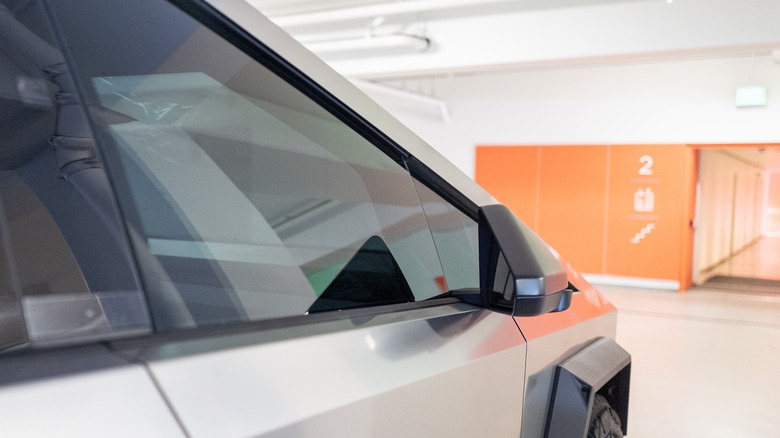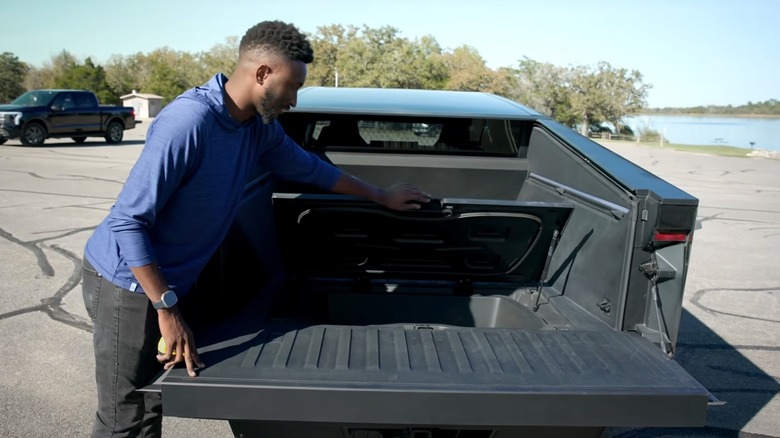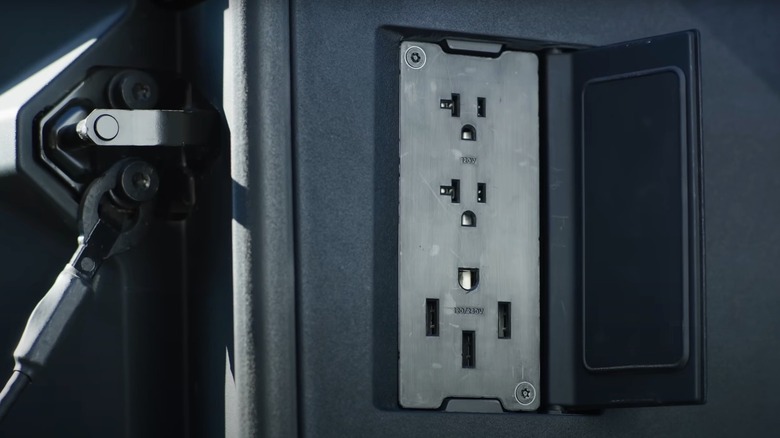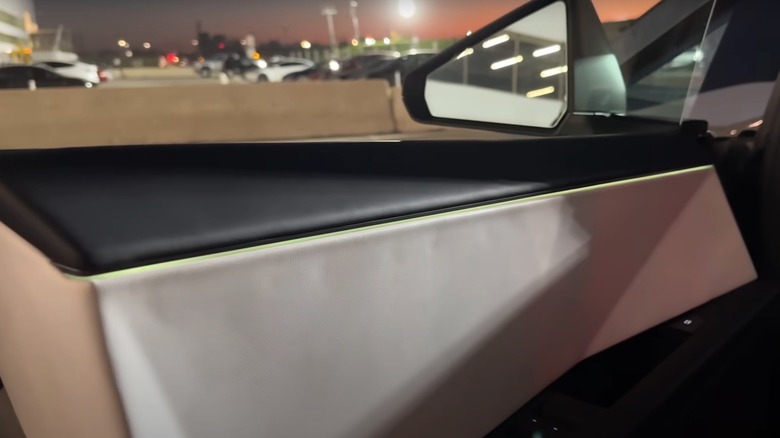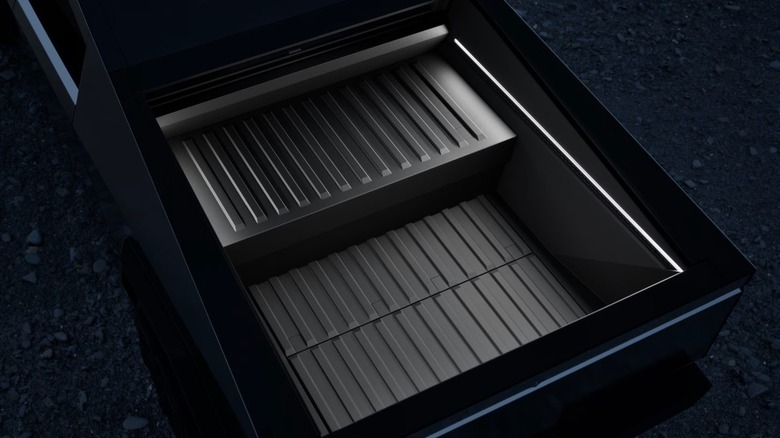12 Of The Coolest Tesla Cybertruck Features You Might Have Not Known About
Tesla's long-awaited Cybertruck is finally here and ready for purchase — though more expensive than anticipated. It's been a rocky road. We started with that controversial 2019 announcement and the memes that followed. One encapsulated the feeling at the time by joking that Elon Musk had drawn up the design with a crayon in his preschool class. Cue delays, production problems, design challenges, and more delays. For those who really, really want to cruise the streets as if they're in Cyberpunk 2077's Night City, the time has finally come. People are already spotting the EV pickup on roads paved and otherwise. Big fish reviewers like Marques Brownlee have put it through in-depth reviews, and the longer it's in the public spotlight, the more heretofore unknown features crop up.
We're not talking about the Cybertruck's powerful LED headlight bar or the curious lack of door handles. We're talking about the little things you may have missed at the original presentation, the launch, or the tech coverage that followed. Here 12 of the coolest Cybertruck's features that probably slipped under your radar.
Easter egg of windows shattering
Everyone's collective memory of the Cybertruck's 2019 announcement event includes the part where Elon Musk tells the audience the vehicle could tough out a warzone with sledgehammer-proof stainless steel sides and shatterproof glass windows. A man stepped on stage to demonstrate the sledgehammer claim and left the Cybertruck with nary a scratch. Good so far. The same person then hurled a steel ball at the windows and shattered them both on the first hit. Awkward. Musk swapped out the steel ball for a baseball during the final unveiling event in perhaps a tacit admission he'd oversold the vehicle's true capabilities.
What shatterproof really means and whether the Cybertruck's windows meet that definition is a discussion we'll leave up to the Tesla crowd. What we do know is that engineers slipped an Easter egg into the final design in homage to that 2019 event. If you open up the Cybertruck's virtualization on the main control panel, you can "shatter" its windows by repeatedly tapping each one. Musk himself acknowledged the Easter egg, which is to be expected since Tesla has gone all in on the gaffe by selling shattered window decals and T-shirts.
Steer-by-wire system
Some Teslas adopted a curious yoke in place of a steering wheel circa 2021, perhaps to make your EV feel more like the Formula 1's unconventional steering mechanism that it's modeled after. The yoke's reception was controversial to say the least, so the Cybertruck fortunately went for a yoke-esque, squared-off "wheel" design this time around. Beyond that, there was one item of note that you wouldn't be aware of unless you drove it: steer-by-wire. Most consumer vehicles use mechanical steering that allow you to quite literally turn the wheels of the vehicle via a gear mechanism combined with power steering to make it easier. Steer-by-wire is all electric and has no physical connection between steering and the wheels.
The Cybertruck Owner's Manual says it works with "sensors in the steering column [that] communicate electronically with the steering racks. As a result, steering Cybertruck feels more responsive and requires less effort from the driver." Marques Brownlee notes in his review that you only have to turn your wheel slightly less than 180 degrees to max out the vehicle's turning radius — no more doing the ol' hand-over-hand motion when pulling a U-turn. Brownlee praises it for making tight driving (such as parking) a lot easier, provided you can get used to it.
Rear-wheel steering
The Cybertruck's steer-by-wire is the perfect segue into another lesser-known feature called rear-wheel steering. The name is exactly what it suggests: The rear wheels are capable of turning independently rather than being locked in a forward orientation. When all four wheels have the liberty to maneuver, the car is capable of making tighter turns than vehicles of the same size without the feature. Marques Brownlee demonstrates how this plays out when compared to the Ford F-150 Lightning, which is comparable in size to Tesla's offering. He overlays a video of the Cybertruck with the steering wheel locked in one direction while pulling off a low-speed donut tighter than the F-150.
That's the biggest benefit over the competition, but rear-wheel steering also adds a handful of other bonuses into the mix. Lane changes (particularly at high speeds) become a lot easier and more stable. Those small adjustments when flying down the highway won't feel as breakneck, either, especially when you're sitting in a heavy electric tank like the Cybertruck.
Mega-strong tonneau cover
Truck bed covers are indispensable for working people who need to keep the elements off whatever it is they're hauling. In typical EV fashion, the Cybertruck incorporates a fancy, automated version in the form of a tonneau cover that opens and closes with the press of a button. It's not perfect — it blocks off your rear view, which is somewhat concerning even with a rear-view camera to compensate. Still, it's a nice touch that's arguably better looking and more convenient than bed covers you have to install and open manually. And it's strong. Ridiculously strong. Unlike the Cybertruck's "shatterproof" windows, the tonneau cover can support the full weight of two human beings.
Marques Brownlee is a big dude at 6 foot 3 inches, so it only made sense for him to really put the tonneau through its paces. His Cybertruck review shows him climbing on top of the tonneau cover and ... silence. The cover holds his weight (even when he stands on one foot) without any creaking or cracking. The only caveat he adds is that while you can stand on it, jumping is another matter. For all the Cybertruck's many, many flaws, that is one impressive feat of engineering — and comforting news for anyone who ever needs to climb onto their vehicle's roof.
Bulletproof body ... kinda
The Cybertruck's shattering windows are one of the first things that come to mind when thinking of the EV, so when Elon Musk claimed his truck was bulletproof, we all put our skeptic caps on. During the 2023 reveal, Musk showed a man unloading a .45 caliber Tommy gun on the vehicle from only a stone's throw away. The truck survived with a bunch of bullet-shaped pock marks, but no holes. Zach Nelson from the YouTube channel JerryRigEverything — famous for bend-testing everything from the iPhone to the Galaxy Ultra — decided to test this claim outside of a staged demonstration.
The bulletproof claim is true, but really only for the smaller-caliber variety. Nelson's testing revealed the Cybertruck can withstand a 9mm Glock handgun round and a .22 rifle , but once you scale up to higher-velocity rounds like the .17 HMR and the AR-15's .223, the lead rips straight through. Credit where credit is due, most car doors are effectively paper when it comes to cover from bullets, unlike how Hollywood portrays them. While we hope no Cybertruck owner ever needs bulletproof doors in the first place, we doubt anyone would turn down that sort of durability and protection.
A bottle opener
You read that right — the Cybertruck has a built-in bottle opener. No, we're not talking about the CyberOpener that you can buy for $50 off Tesla's website (a Cybertruck-shape piece of milled metal), we're talking about one right there in your truck bed. The opener is a tiny nub that mounts along the Cybertruck's L-rails inside the bed. At first glance, you might mistake it for a tie-down anchor to keep heavy loads in check. It's unobtrusive and blends in well with the aesthetic, and is easily removable once you get back from your next fishing trip. Owners of the Foundation Series get it for free, but everyone else can secure their own for $25.
Why did Tesla decide to include a bottle opener, of all things? Probably because this EV is meant to be taken on hikes, camping trips, and used to tow your boat out to the lake. Nothing goes better with those sorts of activities than an ice-cold drink.
A self-cleaning front-facing camera
Cyberpunk aesthetics aside, the main draw for getting a Cybertruck is access to Tesla's smart features and potential for Tesla's Full Self-Driving autopilot somewhere down the line. The Cybertruck has eight cameras in total, including Tesla's first-ever front bumper camera — essential, since some owners report that the truck's front visibility isn't great. While a needed addition, a front camera is exposed to the road equivalent of Seaworld's splash zone. Any dirt, debris, or mud that kicks up could easily blind your truck's digital eyes, especially when you consider Tesla encourages Cybertruck owners to take their vehicles onto uneven, muddy, unpaved roads — or Mars, if Musk's Mars mission ever comes to fruition. It wouldn't be fun to have to get out in these conditions to wipe down a gunked-up camera, so Tesla provides a solution.
The front camera can self-clean at the press of a button. Users just have to tap the spray icon when viewing the camera, and a nozzle will douse it in the same way you might spritz your windshield. Convenient, but you'll have to clean all the others by hand.
Removable side mirrors
The original Cybertruck design included no side mirrors. Given how many cameras it has, it can get along quite nicely without them — though, to be clear, we're not advocating for people to do away with such incredibly important visibility tools. Manufacturers like Tesla have to include side mirrors by law, but Cybertruck owners can remove them if they prefer. Tesla makes doing so surprisingly easy.
All you have to do is pop the door open and expose three bolts hidden under a rubber cover, then remove each bolt with a T40 Torx socket and your ratchet of choice. From there, detach the mirror's electrical control mechanism, push the cord through the door opening, and pull the mirror right off. Then it's just a matter of snapping the rubber cover back in place and Bob's your uncle. Easy.
The only downside is that Tesla doesn't provide caps to cover the holes left by the missing mirrors. You'll have to make your own or prepare for a flooded, rusted Cybertruck body if it rains. Those who are really committed to going mirrorless and relying solely on cameras can dispense with their rear-view mirror as well. It's not that useful anyway considering that closing the tonneau cover blocks your back window.
A hidden second trunk
One of the great things about EVs is that they typically have way more storage space compared to their ICE kin. Once you remove all those unnecessary extra components like gas tanks and transmissions, you end up with a ton of leftover space. After all, the battery and electric motor often only take up the undercarriage and chassis. Most EVs thus give you a full trunk, plus a so-called "frunk" (a trunk at the front of the vehicle under the hood), and often even more. The Cybertruck has a full truck bed and frunk, and there's one additional hidden underbed compartment. After opening the tailgate, you can engage the handle and crack open a small cooler-sized area. It's highly useful as either extra storage space or a semi-secret place to keep things you wouldn't want in plain view when the tonneau cover is open.
As a bonus, the underbed compartment includes a drain plug you can fill with ice to transform the area into a cooler. You can empty out the water with ease later on. It may also simplify your regular cleanup if you hose out the compartment with the drain left open and keep water out of the truck bed.
Bidirectional charging
Reverse charging is a common feature in big smartphones — one we hope the iPhone 16 includes — that lets you share charge with a friend. Thankfully, it has slowly crept into EVs as well. Bidirectional charging is effectively reverse charging, letting you help a friend in need quickly juice-up their EV. If you've got the right equipment, you can even power your home during a blackout. The Cybertruck is one monster of a vehicle with plenty of power to spare, so owners will be happy to know it comes with bidirectional charging via a 240-volt outlet in the bed.
So if you wanted to, you could use your Tesla as a car, a battery power bank, and a backup generator all in one. It's the perfect vehicle if you'd prefer not to leave the comforts of civilization behind when on a camping trip. Or, if you'd rather not keep a noisy generator running just to keep your lights on and supply other utilities.
Customizable interior lighting
Most cars only have one wimpy dome light to help you whenever you need to, say, rifle through your glove compartment in the dark. This is by design. Accidentally leaving the dome light on is one of many ways your battery dies, so imagine what it would do to have a more powerful bulb. EVs don't have that problem since they're all battery, and the Cybertruck's interior in particular sets the bar high for how interior lighting should be.
It's got all the essentials like marker lights, door handle lights, puddle lights, and footwell lights. But it goes a step further with generous rear dome lights on either side of the back seats so passengers can get bright LED lighting when they need it. There are also nifty features like a touch-activated dash light and customizable RGB ambient lights that you can change to your heart's content via the main touchscreen. The cyberpunk aesthetic is all about oversaturated, neon-like colors, so Cybertruck owners will be happy to know they can make the cabin red, blue, green, or purple at the press of a button.
Range extender
The Cybertruck's range is good, but not so good it blows the competition out of the water. At best you'll eek 340 miles out of a single charge, which is only a few dozen more than the average EV at the time of writing. Now, this is an absolutely massive, heavy truck that's meant to lug some of the biggest loads with EV-like acceleration. You may remember Tesla's promotional video race where a Cybertruck appeared to beat a Porsche 911 while carrying another Porsche 911 on a trailer — although some suspect the stunt misrepresented the truth. This is all great news for those who plan to put the Cybertruck to work hauling loads, but not so great if hauling takes you on interstate journeys where range anxiety enters the equation.
For those who need their Tesla to go further, the range extender will be an option at some point. It hasn't been released yet, but it's expected to cost about $16,000 and take up at least a third of your truck bed. You do lose a bit of cargo space, but if Tesla's specs turn out to be accurate, you'd extend your range to almost 500 miles. That's nothing to sneeze at, all things considered, provided you're willing to cough up the exorbitant asking price.
